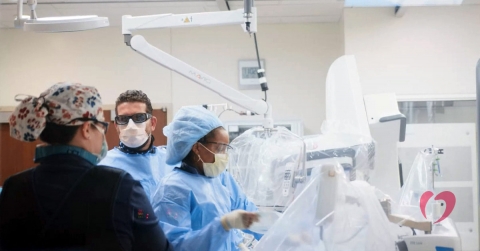What to Expect with an Angiogram

If your doctor suspects you have a problem with your coronary arteries and has not been able to diagnose it with an electrocardiogram, echocardiogram, or stress test, they may recommend an angiogram. A coronary angiogram is one of the most common catheter procedures and is used to diagnose a variety of conditions. During an angiogram, doctors take X-rays of your arteries using a special dye to illuminate them and help see if the arteries are narrowed or blocked.
There are a variety of symptoms and conditions that may lead doctors to recommend an angiogram, including angina, congenital heart disease, symptoms of coronary disease, shortness of breath, or symptoms of a heart attack. Your doctor may first try to determine the cause of these symptoms with less invasive tests, but an angiogram is the clearest and most accurate picture available for diagnosing issues with the coronary arteries.
On the day of the angiogram, your doctor will review your health history and perform a quick physical exam. Once ready to begin, you’ll be asked to lie on a special X-ray table and will be strapped in, as sometimes the table needs to be tilted into different positions during the procedure. You’ll be given local anesthesia but will remain awake during the procedure so you can follow any instructions from your physician.
A catheter will be inserted through an incision on your arm or groin and threaded up the artery to the heart. The catheter delivers a special fluid that allows for clearer imaging while doctors take X-rays of your heart. You may be asked to cough or breathe deeply while doctors observe the movement of the fluid.
If your doctor determines that treatment is needed, they may place a stent in the blood vessels or perform a balloon angioplasty during the same procedure. This lengthens the procedure but treats the problem immediately. When all procedures are finished, the catheter will be removed, and a member of your medical team will apply pressure to the incision site for about 15 minutes to help stop any bleeding. If the catheter was placed through the groin, you will need to remain lying down in the recovery room for several hours after the procedure.
While in the recovery room, your doctor will check on you and discuss the results of your angiogram. Typically, an angiogram is performed as an outpatient procedure, which means you can go home later the same day. Some soreness at the incision site is normal after the procedure, but call your doctor if you experience excessive bleeding, swelling, pain, or signs of infection following an angiogram.
If you have symptoms of heart disease or have a family history of heart disease, schedule an appointment with one of our specialists at Oklahoma Heart Hospital for a consultation.




